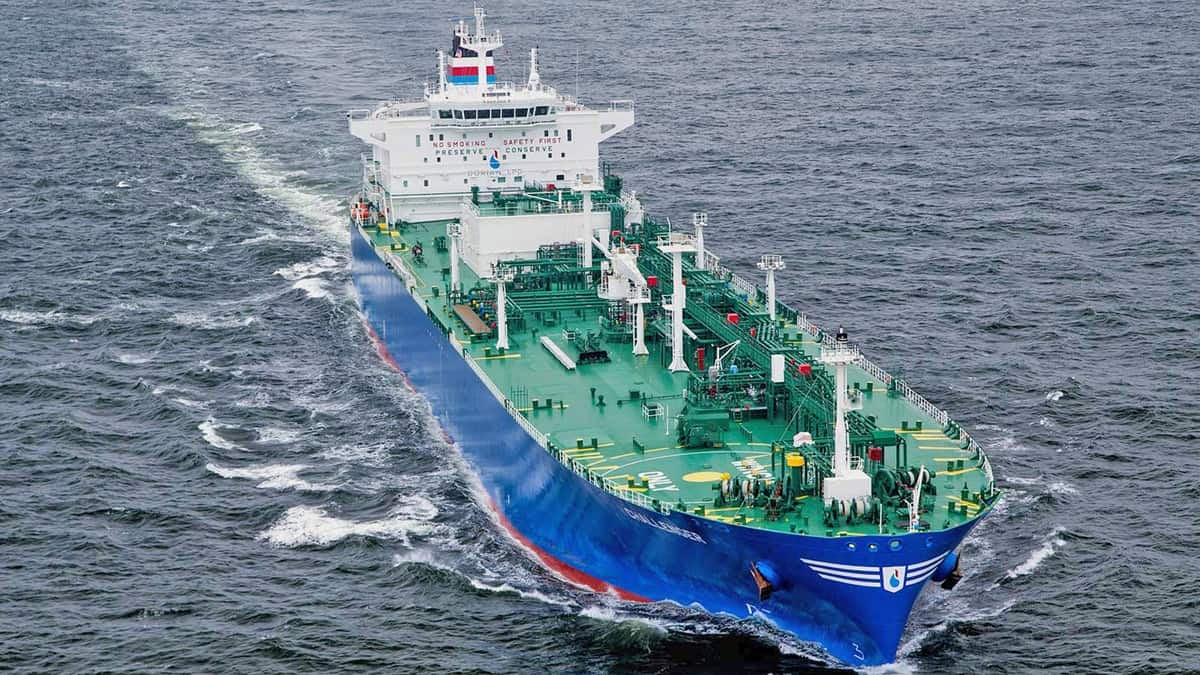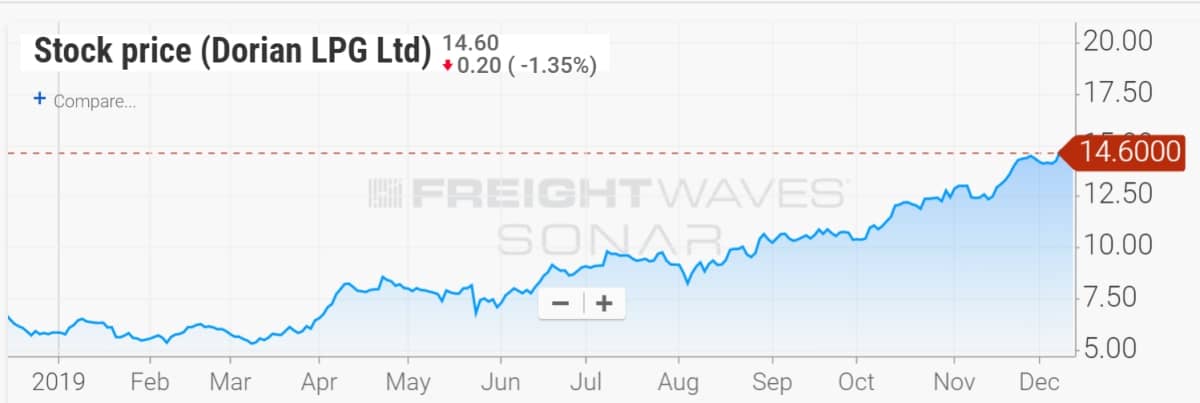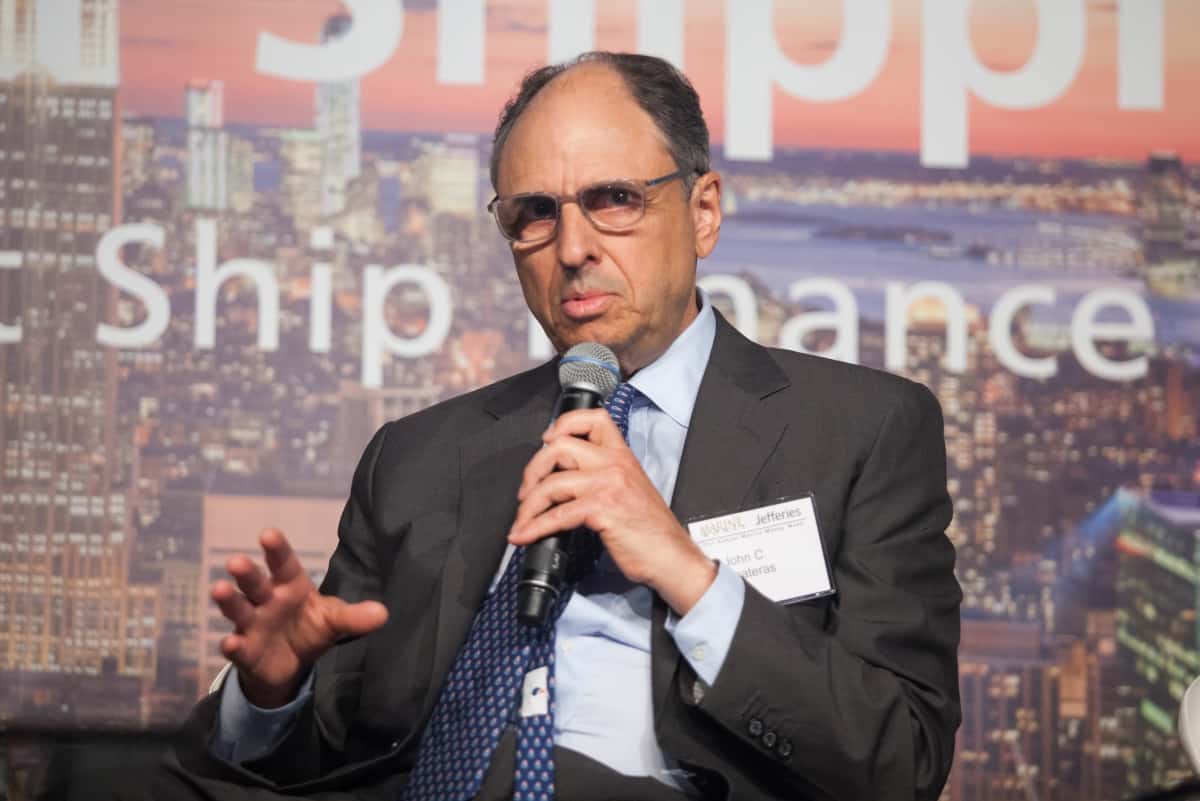If you didn’t buy shares of Dorian LPG (NYSE: LPG) a year ago, alas, you missed out on a “three-bagger” — its stock price has gone from around $5 to just under $15.
The company transports liquefied petroleum gas (LPG), primarily propane and secondarily butane. It sails a fleet of very large gas carriers (VLGCs), vessels with a capacity of 84,000 cubic meters that are the workhorses of the long-haul LPG trades between the U.S. and Asia and the Middle East and Asia.
The Stamford, Connecticut-based owner went public in May 2014 and is now the largest U.S.-listed LPG shipping company, with a market capitalization of $800 million.
On Dec. 12, FreightWaves conducted a lengthy interview with John Hadjipateras, Dorian LPG’s founder and chief executive officer, and Ted Young, its chief financial officer.
The following is an edited version of that conversation:
Why LPG rates have soared
FreightWaves: VLGC spot rates are double to triple what they were last year. At the beginning of 2019, did you think the market would be this strong. What’s driving rates this high?
Hadjipateras: “We came into this year feeling that the supply-demand equilibrium was better and the lines were converging, because in 2018, we saw spikes that were lasting a little bit longer, going a little bit higher, and retreating to higher levels. We saw that the market was poised for an improvement, but you can never tell by how much. The market sometimes forgets to stop on the way down, but on the way up, it’s not quite as forgetful.
“If you had asked us to guess what this year would have brought us, we would have guessed lower — we’re very happy with the result.

“In 2019, we’ve had a continued expansion of production and exports from the U.S. and a continued expansion of demand and imports in Asia. There were also a couple of new factors [that helped the market]: withdrawal of ships for scrubber retrofits [to install exhaust-gas scrubbers to comply with the IMO 2020 rule], some weather delays in the U.S. Gulf, and the trade war, which resulted in marginally higher ton-mile demand [ship demand measured in volume multiplied by distance]. In a grossly over-tonnaged market, these things wouldn’t really make a difference, but in a market where the supply-demand equation is tighter, they did.”
As far as the high spot rates we’re seeing this year, at between $40,000-$60,000 per day, how exposed are you? Different companies have different operating leverage.
Hadjipateras: “We have 22 owned ships and one chartered-in for next year. In the pool [Dorian is a 50/50 partner in the Helios LPG Pool with Phoenix Tankers, owned by Mitsui OSK Lines], we’re operating 28 ships, including ships the pool has chartered-in over short periods. Of our 22 ships, four are out on period charters, so we have 18 ships in the pool that are ours.”
Young: “With 18 ships effectively on spot, we’ve got some pretty tremendous operating leverage. That’s 6,500-6,600 ship days [per year], so every $1,000-per-day increase in spot rates translates into another $6.5 million-$6.6 million to the bottom line.”

Hadjipateras: “Sometimes we outperform versus the Baltic headline rate and sometimes we underperform. You can’t mirror the performance [of the spot market] month by month or even quarter by quarter, because there’s always a lag. Typically, we report higher earnings when the market is falling compared to the current rate and lower earnings when the market is rising compared to the current rate.”
Young: “And that’s not unique to the LPG market.”
The lag effect is acutely apparent this year in both the crude-tanker and dry bulk sectors. I’m curious how long it will be before equity investors figure this out. It doesn’t look like they have yet.
Newbuilding hurdles
John, during a previous interview, we talked about the last time rates were this high, in 2014-15, and how you thought back then that there were barriers to excessive newbuildings — and you were wrong. A large number of new ships were ordered, depressing rates. Today, there’s tremendous uncertainty about what kind of vessel design and fuel system will meet future carbon-emission regulations. Do you think that this time around, newbuildings will be suppressed — that this time it’s different?
Hadjipateras (laughs): “I think it’s different every time but the results are often the same. The reasons we’re not seeing more orders this time are, first, there isn’t the same abundance of money as there was before and second, there’s a fear over what the fuel of the future and the ship of the future is going to be. But even so, I wouldn’t want to predict that this time it’ll be different because the last time we were surprised. You just never know.”
On the future carbon-emission rules, I’m wondering if it’ll be easier for owners to order without the same fear of obsolescence in the LPG space than, for example, in the crude-tanker space. It would seem likely that both liquefied natural gas (LNG)- and LPG-powered ships will serve, at the very least, as transitional vessels to whatever the future low-carbon concept will be. LNG ships are inherently dual-fueled and can run on their own cargo, and we see a lot of LNG newbuildings. LPG ship designs that allow LPG as fuel are starting to be built. Do you think this will ultimately make it easier for an LPG ship owner to order LPG-powered newbuildings than, for example, a crude-tanker owner to order LNG-powered newbuildings?

Hadjipateras: “Yes, I think so. The way we look at it is you’d be giving the charterer the optionality to either burn the cargo as bunkers [fuel] or sell it. Our charterers are mainly traders and oil companies, which are also traders. In this respect, the optionality will have a higher value [versus a ship that transports a different fuel as cargo than it burns as bunkers]. But we can’t really predict whether that will be attractive at any given time because it will depend on whether the price of LPG is cheaper than LSFO [0.5% sulfur low sulfur fuel oil] and we can’t predict prices.”
Growing LPG demand
A lot of the propane going to Asia is consumed by propane dehydrogenation (PDH) plants for the creation of propylene, used to produce polypropylene for plastics production. LPG also goes to the petrochemical sector, where it competes with naphtha as a feedstock, and for residential use for cooking and heating. How much of this demand is yet to be tapped, and how much has the growth of U.S. supply changed the equation?
Young: “One of the challenges in the past has been that prior to 2012, the market was ‘the Middle East and everybody else.’ The price was set by the Saudis and the Qataris, Kuwaitis and Omanis would follow suit. The emergence of the U.S. as the world’s single largest exporting nation — bigger than the entire Middle East collectively — has changed all that. The U.S. has a transparent price [the Mount Belvieu LPG spot price]. If you have more visibility, that should encourage more adoption of the product. In the petrochemical sector, [to switch to propane from naphtha] you usually need to see the arbitrage between LPG and naphtha to be wide enough for a nine-month period. If the Saudis are doing things for their own reasons and that price moves against you, it’s harder for you to make that decision, whereas now, with the transparency provided by U.S. supplies, it creates a self-fulfilling effect.”
And this applies not just to petchem demand, but also to residential cooking and heating use in the Third World, where governments are trying to move people away from burning biomass?
Young: “Yes. You get a big benefit from government support for these initiatives for environmental reasons, and there’s always economics at the bottom of everything. Knowing you’ve got a steady and transparently priced supply of gas from the U.S. makes it a lot easier for governments to support LPG.”
Current events
I wanted to ask you about two key current events: the trade war and the IMO 2020 regulations. Starting with the trade war, China’s tariff on U.S. propane has pushed U.S. LPG to Japan, South Korea and Southeast Asia, and has driven more Middle East exports to China. This situation has turned out to be moderately positive for LPG shipping demand from a ton-mile perspective. If tomorrow there were magically no more tariffs and China and the U.S. loved each other, is that a negative for LPG shipping demand, or does that create more demand?
Hadjipateras: “My sense is that the end of the trade war would lead to an improved economy in China and net-net, it would be a positive for LPG demand. I would rejoice if there were no tariffs on imported LPG into China. I think it would be very positive for our market.”
Regarding IMO 2020, you’re putting exhaust-gas scrubbers on a portion of your fleet, which will allow the use of 3.5% sulfur fuel as opposed to more expensive 0.1-0.5% sulfur fuel. We are now just days away from the regulatory deadline. How is this going?
Hadjipateras: “We’re behind on our scrubber program, like the rest of the industry. I think we’ll enter the new year with seven [retrofitted] scrubber ships compared to our expected 11, in part because of congestion at the shipyards and in part because we postponed some [installations] to take advantage of the high spot-market earnings.

“I’d also like to take this opportunity to make a point. I continually see comments in the press about scrubbers being eco-unfriendly. I’ve even seen people describe scrubbers as cheating the system. We don’t think of scrubbers as a compromise at all. We feel they’re not only compliant, but in some ways, they’re ahead of the game. When it comes to a net-net greenhouse gas [GHG] emission equation from the ‘well to the wake,’ we could point to studies by independent research groups in Norway that show that burning heavy fuel oil and having it scrubbed contributes less GHG emissions than refining the oil you need to burn compliant fuel. I get upset because there’s a whole lot of misinformation. I don’t like that.”
Maybe it’s all a conspiracy of fake news by publicly listed shipping companies that didn’t invest in scrubbers?
Stock pricing
Your stock has done exceptionally well over the past year. It must be getting close to net asset value (NAV, the market-adjusted value of ships plus cash and other assets, minus liabilities). Do you think there’s a lot more room for your stock to run? And with regards to capital allocation, you’ve been buying back stock, but the entire shipping sector is now heavily turning toward dividends. What’s your view on buybacks versus dividends versus debt repayment?

Young: “As far as room to run, we don’t speculate on our stock price and we’re not allowed to disclose our NAV because we get that from our brokers. If you look at where the Norwegians peg our NAV, it’s around where we’re trading. What’s interesting is that VLGC values haven’t really been that volatile. They haven’t gone up that much. So, to answer your question, you’re then looking at a cash-flow-based valuation [versus an NAV-based valuation].
“How do you parse out that excess cash flow? In terms of buybacks, corporate finance 101 says you don’t buy back stock when you’re trading above NAV, so take that for what it’s worth. With dividends, we don’t think you ever get credit [in shipping] as having a sustainable dividend, so we don’t think it’s going to do that much for the stock price — however, we do believe that even an irregular dividend is a good way to improve the total return to shareholders. Debt reduction has merit because you permanently improve your cash flow, but on the other hand, investors want to see something now, so debt reduction is probably lower on the list.
“You can do all of these simultaneously, by the way. Also, we really do believe in a strong balance sheet and holding sufficient liquidity to enable us to get through any rate environment, so holding some cash and not paying down debt or returning cash to shareholders is also very much in the cards for us.”
Whatever you do next, your stock has tripled over the past year. Congratulations. Not many shipping companies — except, of course, all those that did reverse stock splits — can say that.
Hadjipateras: “I hope you bought some stock.”










